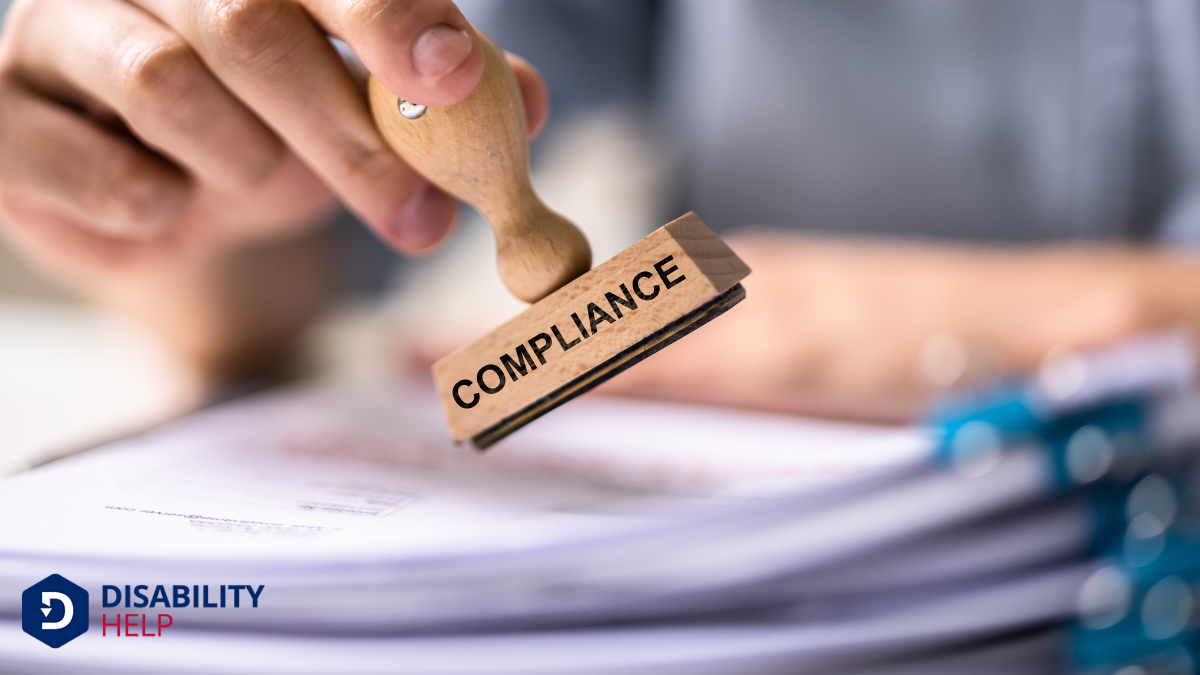Let's explore how Title II of the ADA safeguards the rights of individuals with disabilities in accessing public services. It requires state and local governments to make reasonable modifications, guarantee effective communication, and maintain accessible facilities. We might wonder, though, how these obligations translate into real-world changes and what mechanisms are in place to enforce compliance. How do these protections empower us to advocate for a more inclusive society?
Key Takeaways
- Title II mandates equal accessThe principle that all individuals, including those with disabilities, should have equal opportunity... to public services and programs for individuals with disabilities, preventing discrimination.
- Public entities must provide reasonable modifications without altering the nature of services to accommodate disabilities.
- Effective communication standards require necessary aids, ensuring clear access to informationThe right of individuals with disabilities to obtain and use information, often requiring accessible... for individuals with disabilities.
- The DOJ and OCR enforce compliance with Title II, offering legal recourse and technical assistance to public entities.
- Individuals are empowered to advocate for accessibilityThe design of products, devices, services, or environments to be usable by people with disabilities...., influencing policies and creating inclusive environments under Title II.
Overview of Title II and Its Scope
Title II of the Americans with Disabilities Act (ADA)A U.S. law that prohibits discrimination against individuals with disabilities in all areas of publi... guarantees that individuals with disabilities have equal access to public services and programs. This means that public entities must make their facilities, services, and programs accessible to everyone, regardless of ability.
We guarantee that our communities are inclusive by identifying and removing barriers that hinder participation for people with disabilities.
Under Title II, public entities include state and local governments, as well as their departments and agencies. These bodies are required to modify policies, practices, and procedures to avoid discrimination.
This scope guarantees that, whether we're talking about public transportation, educational institutions, or recreational facilities, individuals with disabilities can participate fully.
Our shared goal is a society where everyone can engage and thrive without barriers.
Obligations of Public Entities Under Title II

As we explore the obligations of public entities under Title II, we must understand their duties to guarantee equal access for people with disabilities.
These entities are required to make reasonable modifications to policies and practices to accommodate everyone effectively.
Additionally, they must adhere to communication standards that ensure all individuals can access and understand the information provided.
Equal Access Requirements
When we consider the equal access requirements under Title II of the ADAThe section of the Americans with Disabilities Act that prohibits disability discrimination by publi..., it's clear that public entities have an essential role in guaranteeing inclusivity for individuals with disabilities. They must provide equal access to programs, services, and activities so everyone can participate and benefit.
This means facilities should be physically accessible, communication methods must accommodate various needs, and all individuals should have equal opportunities regardless of their abilities.
We need to remember that barriers aren't just physical. Public entities must also address attitudinal and procedural obstacles that could prevent full participation.
Our commitment to this inclusivity guarantees that those with disabilities experience the same level of access as everyone else. By doing so, we create a more equitable society for all individuals.
Reasonable Modifications Mandate
While ensuring equal access is essential, public entities also have an obligation to make reasonable modifications under Title II of the ADA.
These modifications help accommodate the unique needs of individuals with disabilities, ensuring they can participate fully in public services and programs.
We must understand that "reasonable" means changes that don't fundamentally alter the nature of services or cause undue financial or administrative burdens.
For example, a city might provide alternative methods for completing forms or adjust policies to better serve individuals with disabilities.
When we prioritize these adjustments, we demonstrate respect and inclusivity.
It’s vital that public entities assess how they can implement changes that balance accessibility with their operational capabilities, creating an environment where everyone can thrive.
Effective Communication Standards
To guarantee inclusivity, public entities must adhere to effective communication standards under Title II of the ADA.
We, as a society, need to make certain that everyone, regardless of disability, can access information and services. These standards require public entities to provide necessary aids and services, like sign language interpreters or Braille materials, to facilitate effective communication.
We can't overlook the importance of considering the specific needs of each individual. It's about more than just providing tools—it's about making sure these tools are appropriate for the situation.
We must actively engage with individuals to determine the best methods of communication. By doing this, we promote equal participation and prevent communication barriers, creating a more inclusive environment for everyone.
Ensuring Program Accessibility and Effective Communication
Let's explore how Title II of the ADA guides us in making programs accessible and communication effective for everyone.
We need to focus on removing physical barriers that might prevent access and providing auxiliary aids to assist those with disabilities.
Removing Physical Barriers
When we think about accessibility, removing physical barriers is essential to ensuring that everyone, regardless of their abilities, can participate fully in community life.
Under Title II of the ADA, public entities are required to make their facilities accessible to people with disabilities. This means adding ramps, elevators, or automatic doors where necessary, and ensuring that paths of travel are clear and navigable.
It's about making sure that public spaces, like libraries, parks, and government buildings, are welcoming and inclusive for all.
As a society, we've a responsibility to identify and eliminate obstacles that prevent people from accessing services and opportunities.
Providing Auxiliary Aids
Communication is an essential part of accessibility, and Title II of the ADA guarantees that people with disabilities have equal opportunities to engage in public programs and services.
We must provide auxiliary aids to guarantee effective communication. These aids can take various forms, each tailored to specific needs:
- Sign language interpreters: Essential for individuals who are deaf or hard of hearing.
- Braille materials: Provide access for those who are blind or have low vision.
- Assistive listening devices: Enhance auditory information for those with hearing impairments.
Implementing Effective Policies
Crafting and enforcing effective policies are fundamental steps in ensuring program accessibility and effective communication for people with disabilities.
We must first understand that these policies act as a roadmap, guiding our institutions to inclusivity. By setting clear guidelines, we can guarantee that our programs are accessible to everyone, regardless of their abilities.
We should also focus on training staff to recognize and address the varied needs of individuals with disabilities. This training is essential for eliminating barriers and fostering an inclusive environment.
Let’s not forget the importance of regularly reviewing and updating our policies, ensuring they remain relevant and effective. By doing so, we’re not just compliant with Title II of the ADA, but also champions of accessibility and effective communication for all.
The Role of Reasonable Modifications in Public Services
Although public services aim to serve everyone, they sometimes need to make reasonable modifications to guarantee accessibility for people with disabilities.
These modifications are essential under Title II of the ADA, ensuring that everyone can benefit equally from public services. We must understand what these modifications entail to appreciate their role.
- Flexibility in Procedures: Adjusting rules or procedures when necessary, like offering alternative communication methods.
- Physical Changes: Modifying physical spaces, such as installing ramps or widening doorways, to improve access.
- Auxiliary Aids: Providing tools like sign language interpreters or assistive listening systems.
Mechanisms for Enforcing Title II Compliance

To guarantee Title II of the ADA is upheld, robust enforcement mechanisms are essential. We must confirm that public entities comply with these standards to protect the rights of individuals with disabilities.
The Department of Justice (DOJ) plays a critical role by investigating complaints and taking legal action when necessary. They can negotiate settlements or bring lawsuits to enforce compliance. Additionally, the DOJ provides technical assistance to help public entities understand their obligations under Title II.
We also see the Office for Civil RightsThe rights of individuals to receive equal treatment under the law, including protection against dis... (OCR) within the Department of Education taking part by addressing issues in educational settings. These agencies work together to oversee and confirm compliance, fostering environments where everyone has equal access.
With these mechanisms, we can hold public entities accountable effectively.
Empowering Individuals to Advocate for Accessibility
While enforcement mechanisms are essential, empowering individuals to advocate for their own accessibility rights is equally important.
By equipping ourselves with knowledge, we can become effective advocates for change. Understanding our rights under Title II of the ADA is the first step towards ensuring that public entities respect and implement these rights.
To effectively advocate, we can:
- Educate Ourselves: Learn about the ADA's provisions and how they apply to various public settings.
- Engage with Others: Join local advocacyThe act of arguing in favor of, supporting, or defending the rights and interests of individuals or ... groups to share experiences and strategies.
- Communicate Clearly: Articulate our needs effectively to decision-makers and public officials.
Together, we can create a more accessible world by actively participating in shaping policies and practices that affect our lives.
Let's empower each other and drive progress.
Frequently Asked Questions
How Does Title II of the ADA Differ From Title I and Title III?
Title II focuses on public entities, ensuring equal access to services and programs. Title I addresses employment discrimination, while Title III targets public accommodationsModifications or adjustments in healthcare settings to support patients with disabilities.. We should consider each title's focus to understand its unique protections.
What Types of Public Transportation Are Covered Under Title II?
Let's explore public transportation under Title II. It covers bus systems, rail services, subways, and any state or local government-operated transport. We, as a community, benefit from accessibility enhancements, ensuring equal access for everyone, including those with disabilities.
Are There Exemptions to Title II Compliance for Certain Public Entities?
Let's explore exemptions. Title II generally requires public entities to comply, but certain small local governments might have partial exemptions. It's vital we comprehend these nuances to guarantee we're advocating effectively for disability rightsThe legal and human rights afforded to individuals with disabilities, often the focus of advocacy an... and accessibility.
How Does Title II Address Digital Accessibility for Websites?
We guarantee digital accessibility by applying Title II regulations to websites, mandating that public entities make their digital content accessible to everyone, including people with disabilities. This way, we foster inclusivity and equal access in the digital domain.
Can Private Organizations Be Held Accountable Under Title II?
Let's explore accountability. Title II generally applies to public entities, not private organizations. However, some private organizations may be considered state actors under specific circumstances, potentially holding them accountable. It's essential to understand these nuanced legal distinctions.
Conclusion
In summary, we've explored how Title II of the ADA plays an essential role in safeguarding the rights of individuals with disabilities. By mandating reasonable modifications, ensuring effective communication, and requiring accessible facilities, we help create an inclusive environment. Public entities must adhere to these obligations, empowering people to advocate for their rights and participate fully in society. Let's continue working together to uphold these standards and foster a community that values diversityThe inclusion of individuals from a wide range of backgrounds, including people with disabilities. and inclusionThe practice of creating environments in which any individual or group can be and feel welcomed, res... for everyone.






